Sakau en Pohnpei Nights Market Reviews
Final update:
The functionality of this page ended on . While I no longer attempt to systematically report on sakau markets, current information on sakau and sakau-related activities including the occasional report from a market is now reported in my blog under the sakau tag.
The Unofficial Mehnwai Guide to Sakau en Pohnpei
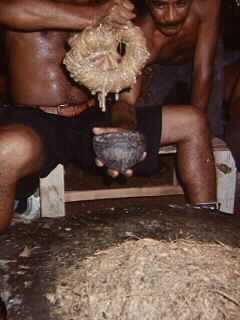
Kaselehlie maing! Sakau en Pohnpei is a Micronesian variant of Polynesian kava. Sakau en Pohnpei is prepared from the root of the pepper plant by pounding the root upon a basaltic sakau stone. The pounders are also basalt, often rounded river rocks. The sakau is then squeezed through a wrap of the inner bark of the tropical hibiscus tree. The hibiscus contributes a viscous sap to the sakau. The result is a thick brown goopy liquid that is consumed from a communal coconut cup. Sakau starts at sunset, after eight is too late.
Etiquette: If one goes to sakau, one should consume sakau. When one is full, it is time to leave. There is an impoliteness in remaining at sakau and not consuming. Do not consume alcoholic beverages at sakau except for the allowed single can of beer to clear the taste from the mouth. No hard liquor ever. Sakau is a time for quiet. In its traditional format only one person around the stone speaks at a time. Sitting quietly and listening is the appropriate behavior for sakau time. Close your eyes when you drink, observe how others drink and do likewise. Spitting is de rigueur at sakau.
For the visitor to Pohnpei, town water is treated and relatively safe. Village water is safe for us who live here, but is not recommended to the visitor.
Tourists should probably avoid bottle sakau, there is no way to know the water source. Bottle sakau is for local stomachs only. The area where bottles are being sold from coolers near Spanish Wall is referred to as "no choice" market. That should give one an idea of the quality. Those who can buy from the villages, but then there is the matter of the water quality.
Sakau places are created whenever someone gets the urge to open one, and close as a place of business whenever the family tires of running it. Being family run, they often close for family events and unexpected holidays. The lifespan of a sakau en Pohnpei business is rarely more than a few years, those listed below may or may not exist should one find their way to Pohnpei.
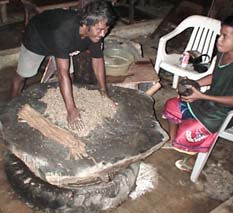
In June 2000 I took a breather from sakau consumption. I was clearing up my second case of amoebic dysentery. One can only take Fasigyn a certain number of times in a lifetime. A month earlier, in May, cholera had appeared for the first time on Pohnpei and the subsequent epidemic took 19 lives and affected 3,000 of the 34,000 people on the island. Sakau is not addictive, I did not go through any withdrawal symptoms despite my seven year habit.
In October 2000 I took part in the consumption of an experimental oral cholera vaccine. I remained sakau free through Christmas. I now occasionally return to the stone on a Friday night for a cup of slime and good conversation.
The markets have changed their style of service, with most markets giving each customer their own cup. Pohnpeians have returned to the stone in full, cholera or no cholera. There are still cases of cholera, but the vector appears to be poor sanitation and not sakau per se.
This document is horribly out of date. All spelling on this document are mine and have no relation to Pohnpeian orthography! All of the following is written by a mehnwai and is thus meaningless.
I am occasionally found around sunset on a Friday evening belly-up to a stone consuming mud in the wormy search for that finer brew of sakau. Accuracy of the content is purely subjective. Sakau is best located by word of mouth rather than by the written word.
Places to consume sakau en Pohnpei
Kolonia
Six Eleven
In the Spring of 2003 I moved my Friday nightly visits to the stone to Estanis Suldan's 6-11 Market in Kolonia. Close to home and strong on a regular basis, 6-11 is a salary man's and women's night out town market. The service is superb, and the table cloths and napkins are just plain special for a sakau market. The root is brought in and served from the stone. I continue to avoid bottled sakau, my passion is for the stone. Six Eleven is easy to find, located at the three-way intersection of the Dolihner - Kolonia town - and Sokeh's roads. 6-11 is a moderately late starting market, with start around 7:30. I've seen arrivals as late as 10:00 on a Friday night, I've nipped in at 9:00 on a couple occasions and been quite content.
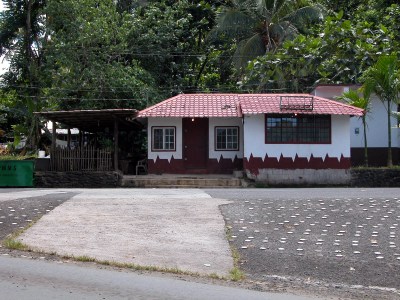
This is also a multi-lingual market with Pohnpeian, Kosraen, and English all being spoken by the work force. In a pinch a translator for Marshallese can also probably be located (2003).
November, 2005. Six-eleven continues to serve sakau from the stone. The market is usually open Wednesday to Sunday, occasionally Monday and Tuesday. The service remains excellent, the sakau is clean. The quality may not be what it has been in the past, but this is such a subjective night-to-night thing that it is hard to know for certain. Six-eleven remains open at the time of this writing in August 2008 and has seen a resurgence in popularity during this year of high fuel prices.
6-11 has always used the fixed price system, all you can drink for six dollars.
Nett
Koahn
Owned and operated by Joe Felix, Jr., Koahn is the newest powerhouse sakau market in Nett. Serving strong sakau on the rock, the market has a reputation for consistency and cleanliness. Sakau is an unpredictable substance, Pohnpei has no ability to determine the strength of a given sakau plant. Despite this inherent unpredictability, Koahn has developed a reputation for inducing the dream time night after night in its customers.
Koahn is frequented by the politically connected and business powerful. This is the power market in 2008.
Koahn also wins the "best place for a tourist to try sakau" award in 2008. Clean conditions, clean water, a host who is fluent in English, and traditional service style combine to make this the 2008 tourist recommendation.
Koahn is a six dollar, all you can drink, pass the coconut cup market. Koahn lacks a store, bring your own can of soda.
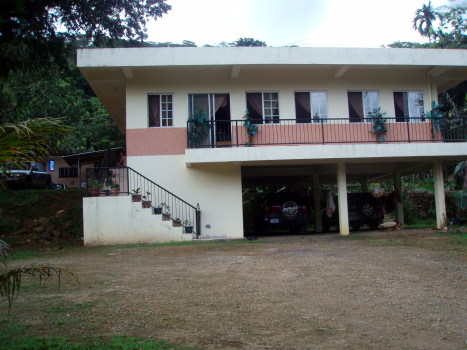
Koahn is located behind the home of Joe Felix Jr. in Nett.
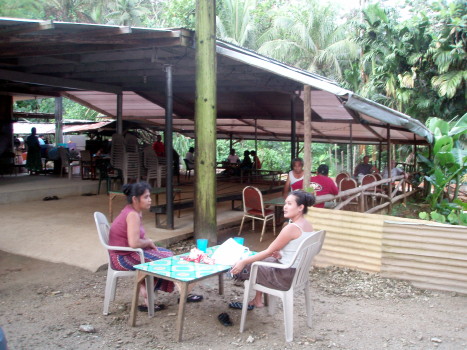
Koahn features a large cement patio under a wood and canvas roof.
Koahn and 6-11 share the distinction of having the most area under roof of any market on Pohnpei.
The stones are at the back left in this image.
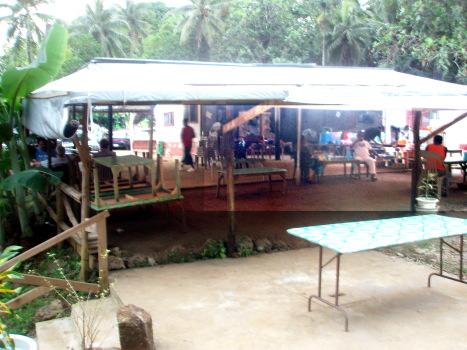
Koahn has an outdoor patio for those who do like to sit out under the open sky.
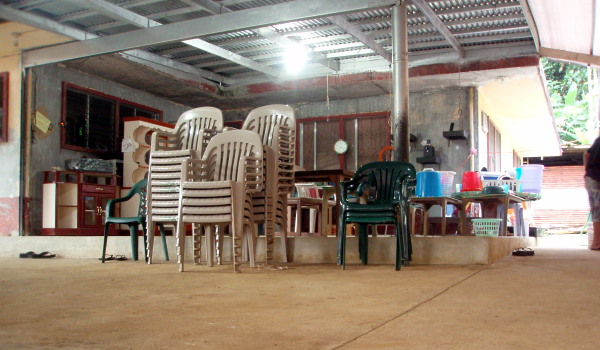
Centrally located in the interior are supplies of water.
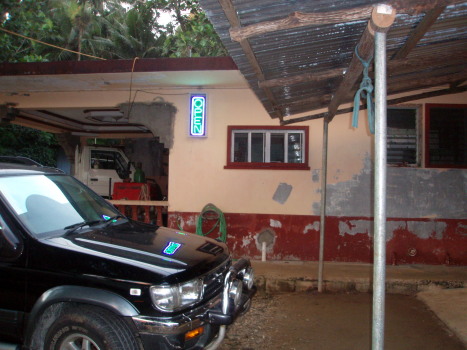
Unique among the markets on Pohnpei, a neon sign announces market status. Other markets use a wood board or cardboard sign. The neon sign bespeaks of the upscale nature and ambience of this market.
Green Bay
The original Green Bay was located just across the Dausokele bridge back in 1993 and 1994. Sometime in the mid-1990s the market disappeared. Eventually a store appeared at the location. Spring 2007 the market reopened. The market returned to the marketplace a traditional stone service not seen since before the cholera outbreak of 2000. The market serves using a ngarangar direct from the stone to the table, with a server passing the same cup to each person at the table. As in the days of yore, everyone at the table drinks from a common cup. The cup unites us.
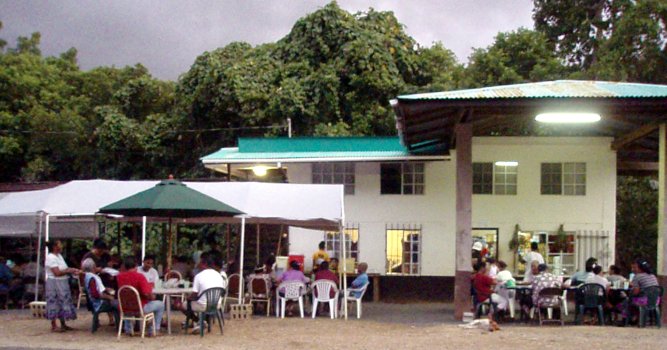
Although the market has only been open a brief period of time, the market has already forged a fiercesome reputation for ferociously strong sakau. Two stones are used. The market has an ability to handle crowds that experience tells me should not be possible. The market can handle 60 to 100 people and have everyone go home nice and sleepy. These day the market is more commonly refered to by the owner's name "Kusto" to distinguish the market from Koahn market across the road.
Green Bay uses the "all you can drink" for six dollars system if you arrive before six, seven dollars after six. If Kosraen sakau is being served, the price can climb to ten dollars, still in the "all you can drink" format.
Rush Hour
10 May 2004. Located on the west bank of the Nett River at the Dausokele bridge. Open air, traditional hut plus some tents. Very breezy - a plus for sakau drinkers. Pohn takai prepared on site and then poured into cups. A medium cup is one dollar, a large cup is two dollars. Refills are fifty cents per tot, with a medium cup requiring two tots. Grand view of the Nanpil river and Nett Point ridge. The market is a 5:00 starter - hence the name rush hour. This is a market where eight is too late. People are finished by eight. Generally strong sakau, although strength may be waning with time and tide. A favorite of Nett based mehnwai.
Rush hour saw a collapse in quality during late 2005 and many people abandoned the market.
The market was given new paint, tables with tablecloths, and - briefly - strong sakau in 2006. By 2007 the quality had again collapsed and the market caters to virtually no one. Spring 2007 a formidable competitor in the form of a resurrected Green Bay took dominating control of the local market scene.
As of August 2008 the market had devolved into a bottle market. The market sells bottles filled by farmers in the Meitik valley up river, customers can sit in the market and drink. Bottles are three to four dollars each.
Rush Hour is a dollar a cup.
Nett Palipowe
Palipoa is located on the East side of Nett Point, use the "back" road to get there. There were once five sakau en Pohnpei markets along this coralline road, with the strength increasing until one reached the last place on the right. The strongest sakau on the point was the Sekeren variant grown near the tip end, usually served up at Nahnsou Sed en Nett's place, the last of the five. Three of the five sported a view of the ocean. This was village based drinking: tradition and respect are always important here. Be careful, these brews pack a lot more punch than found in town. These are family oriented places as opposed the business and governmental orientation of the town bars. These are all single cycle one to three stone places, so the strength ebbs with the deepening of the night. The water source is variable. Be there by sunset and observe sakau etiquette. Palipoa is now home to the Nahnmwarki of Nett, so there is now an extra pull toward the traditional up this way. As of fall 2003 only Loyola's was still in occasional, irregular operation. The market would cease to operate for a couple years. Rumors heard in early 2007 suggest the market was irregularly open again. Loyola's continued to operate on an occasional basis in early 2008.
Sokehs
Ekisekis
Kitti
Song [ie] mahs, Pehlung
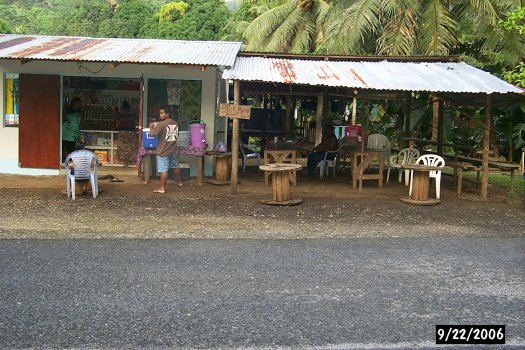
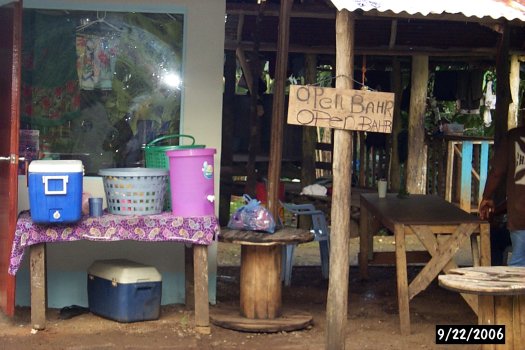
November 2005. Try me [first]. Like many market titles, Song Mahs is a double entendre. A market in Kitti just north of Pehleng. The market is on the upslope of a hill between the Sawartik stream and Nankapw, Pehleng. A local market on village water with sakau at full rural strength. There is a vast difference these days between town sakau and village sakau. Where in town might comfortably consume four, six, or even eight tal (coconut cups), many village markets will have you sailing away into that wonderful sakau haze after a mere two or three cups. A Friday night session at Song mahs had me diplopic after three cups. The night still being young, as in the sun had just barely set, I tipped down a fourth cup of a brew with plenty of mataitai and no katik. I remained oan sakau right through to Sunday morning.
By fall 2006 Song Mahs had become a new Friday evening home for this author. A dollar cup.
Nankapw, Pehlung
November 2005. Nankapw, at the curve, is an "in-the-road" market of small size but consistent sakau. The market has shown great longevity, consistently serving a potent brew since sometime around 2000 or 2001. The market is located just up the hill from Song ie mahs toward Pehleng.
Nankapw remained open in the fall of 2006. A couple cups at Nankapw followed by another two just down the hill at Song Mahs is sure to help the drinker find the hidden bridge to the third heaven.
By 2007 Nankapw had moved the store to a new structure and put a pool table in the location of the store. The market itself remains unchanged, but now attracts a younger and somewhat noisier clientele.
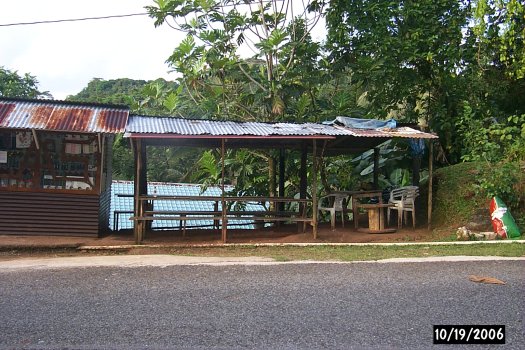
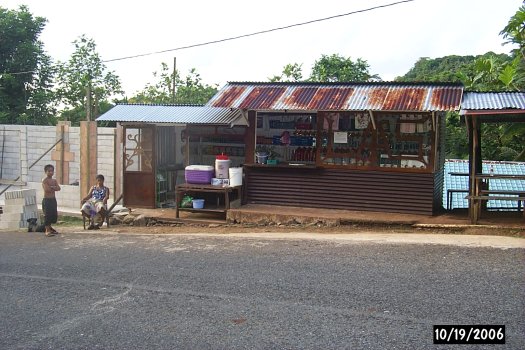
Pwopwuda, Pehlung
October 2005. Pwopwuda needs no translation and could not be translated in any case. The market is located just one hill south of Pehleng on the inside of a tight curve. Pwopwuda is a rarely attained state of nirvana that one is fortunate if one attains once in a lifetime of consuming sakau. Run by Kapriel Spencer, Pwopwuda - when serving the owner's sakau - gives you the best shot at attaining that state. Water is village local. Service is by the cup, the sakau is pounded up at Kapriel's place on his stones high in the mountains above Pehleng. Kapriel has a local reputation as a purveyor of sakau to maintain, he serves nothing less than the best. The complication - like many market owners he also loans out his market to third parties on some occasions. In November 2005 the market was closed for renovations. The market reopened and remains in irregular service as of spring 2007.
Historic Information
The following information is kept for historic purposes only. Most if not all of these markets are closed and long gone. There are a lot of new markets, especially out in U. I have yet to sample these markets.
Kolonia
Bismark's
Bismark's is located on the waterfront in Kolonia and serves from stone to bucket to individual cup, a modern service variant. Those who wish to consume at their own pace will find this service method to their liking. Bismark's has a glorious sunset view of Nett upon the water and Lenger Island. The water source is town water. Closed since before the turn of the century.
Nanwel (in the high jungle)
Nanwel is an immaculately clean market up in Nahnpohnmal. The market would not be easy for an outsider to find, best to take a taxi and have them drive you there. For locals, drive past Triple K, on past the Lucky Seven service shop and take the second dirt road on the right. Go past the nahs on the right side and Nanwel is just behind the nahs.
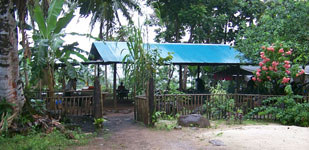
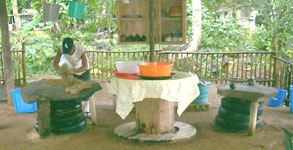
Nanwel has a fully stocked store with all the standard lihder and then some. The market is a dual stone continuously reloading market.
Nanwel has looks out toward the mountains of Twemwentwemwensikir and the Palikir range, the sunsets can be spectacular up here along the cliff line. Service is the absolute fanciest I've seen yet on island. You have a choice of an individual coconut cup or a bar glass. Each service is set on an individual towel. The water is town water.
The sakau is strong and smooth with just the right amount of mataitai for the veteran drinker. In fact, better to take a taxi as you might be too cross-eyed to drive home after an evening of rock-paper-scissors at Nanwel.
The owner is from Sokehs, his wife is from Kitti. As of 2003 I have been informed that Nanwel is open on a less regular basis. Status in 2007 is simply unknown, presumed closed.
In 2008 Nanwel returned to Wednesday to Saturday nightly operations. If anything, Nanwel 2008 handles more customers than ever before. Nanwel retains the double stone, with service available either in a glass or passed cup. The market remains an all you can drink for six dollars as of summer 2008. Nanwel remains upscale, serving not in plastic cups but in glasses. The market is clean and uses town water. The market remains hard to find, which adds to the charm. Tucked back on the edge of the steep slopes of Nahnpohnmal, the market still feels like it is in the middle of the forest instead of the middle of town. This is an excellent choice for a visiting tourist, although one might need a local guide to find the market.
Panuelo's
Panuelo's is on the road to Dolihner and features a single stone. This is a popular and convenient location to meet local governmental and business leaders. Arrive early to secure your seat, the stone is single cycle and the strength fades into the night. The water source is town water. Closed since an election in the 1990s.
Rukih Ruk
Rukih Ruk by Augustine Damarlane. Located in Dolihner section, Rukih Ruk was in its first incarnation the only choice for visiting tourists. The water was and is town water and the service was traditional communal cup directly from the stone. Rukih Ruk had multiple stones each set in its own thatched roof hut and could usually handle larger numbers of people than most other places. Rukih Ruk opened again in the Spring of 2002 with two revamped huts. Service is by communal or individual cup. I spent a couple lovely evenings there Spring 2003. Augustine remains delightfully acerbic. Rukih Ruk would probably still be a first choice for me if I were to take tourists to sakau. The market remains the most gardenlike of the town markets.
While Rukih Ruk remained closed, Augustine would open a new market just up the road from Rukih Ruk toward the state gym in the fall of 2006. This market remains unreviewed. From external appearances it is a "bottle market" in that in serves sakau in bottles. The market has a pool table.
In summer 2008 Augustine rebuilt the main hut at Rukih Ruk and the market reopened. Details on the service and price are unknown to this author as of August 2008.
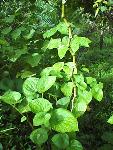
Triple K
Although of late Triple K has been open and closed, Triple K was the longest continuously running sakau market that I know of on Pohnpei. With at least ten years under the belt, Triple K in Nahnpohnmal on the cliffside road had a well-deserved reputation for serving strong sakau and good conversation. Triple K is a town market and a frequent haunt of politicians and civil servants. By 2005 or so Triple K was permanently closed. Immediately next door a market was opened, the name of which I never learned. The market was a "pool table" market in that it included a pool table. I drank there on only a couple occasions, one of which was fund raiser for students at the college. This market may still be irregularly open in 2007, but I rarely find my way up to Nahnpohnmal for sakau these days.
As of 2008 the neighboring market had closed. The same family opened a new market on the other end of their property which is, in the modern parlance, a "pool table" market. The market includes a pool table and, I gather, lucky number draws. The market is, in the mind of this author, a social destination. A fun place to be and to be seen. Reports are that the market is a solid market, unreviewed by this author as of August 2008.
Stroke
November, 2005. Stroke, run by Senator Fernando Scaliem, is the hot Kolonia market of November 2005. Serving strong sakau to large numbers of people, the market may ultimately be too successful. The market is pulling sixty plus patrons on a Friday due to its ferocious reputation for paralyzingly strong sakau. My years of sakau marketing have taught me that serving such strength to such numbers tends to burn out the squeezers and chew up a lot of sakau very quickly. That said, there might not be the intent for a long haul. The five dollar fee is going to a children's Christmas gift fund, the market ceased to exist after summer 2006. The brew was strong, the patrons were cosmopolitan, and the conversation was political.
Urohs
Located along the road between Kolonia and Sekere near the Sokeh's junction, technically in Pahnasang, Sokehs. Sits directly adjacent to the road. Bottle only. Excellent bottle on 03 June 1999. A place to drink and see everyone who drives by on the main road. Has the unique distinction among sakau markets of being located across the street from a Mormon temple. Not recommended for tourists. The mouth wash water is local pipe. Was open only briefly, closed permanently within the year.
Nett
Paulino Nansou Rodriguez
May 2004: Closed indefinitely. Sakau thinned during late 2003, with mehnwai near on the last paying regular customers. Family debt may have been the cause of closure: immediate family drinking for free may have destroyed the margins. I was sad to see it go. The market remains closed as of 2008.
12 December 2003 Located at the junction of the main circumferential road and the entrance road to Palipoa, Rodriguez' market has utilized dual stones with continual reloading to keep the sakau strong. I've seen the market serve forty with everyone going home satisfyingly sakaula. Not since the glory days of Rukih Ruk has a market been able to serve so many. The source of the sakau varies, but it has been invariably strong.
When I returned to market in late 2000 after the peak of the cholera epidemic, it was to Rodriguez' place. This market was, as far as I know, the first market to receive Pohnpei EPA certification after the onset of the cholera epidemic. In fact, once Pohnpei decided to have EPA review markets, the owner was the first person to attempt to follow the new law. They continue to hold a high standard of cleanliness. The water here is town water.
Paulino's remained the mehnwai market through Fall 2002 and continues to be the place one can most regularly find mehnwai drinking. Regular mehnwai patrons include Kaniki en Dolop Nett and Orun en Ledow Nett.
Service is in an individual coconut shell, so you can drink at your own speed. Paulino's is an early market, starting around six. Customers start leaving after nine and by ten the market is quiet. My own rule of thumb in 2003 is to not show up after 8:00, there just isn't the strength in the brew after that time.
Fall 2003 Nansou's place even on a Friday evening is a quiet spot with only a few hard core regulars including a couple remnants of the old mehnwai crowd. I do not know why Nansou's has lost its cachet, but those who drink at Gabriel Spencer's place in Kapwkapw, just past Pehleng in Kitti, claim the strength is gone.
Paliais Nett -El Niño
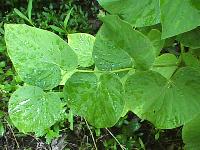
24 April 1998. The El Niño sits on a clifflet with a view out over the Nett river and tidal inlet. The El Niño is a pohn takai market, with a distinctly impermanent look to its construction and placement. The clientele is Paliais local and Kolonia town inhabitants. The brew is a smooth, strong, shady side of the point brew. The sakau lacks distinguishing and distracting overtones. The market sieves the brew, creating a sakau that without the usual flotsam and jetsam typically found in sakau. Two stones were in action on Friday night on a staggered start schedule. Eight was not too late for the El Niño that night.
The view is enhanced by the lights of the new PCR restaurant at Nantelik's across the water. PCR 's lights are too distant to disturb the drinker, but close enough to play and dance upon the shimmering water. In the distance diners can be seen moving to and fro, enjoying an elegant evening on the town. The market, dimly lit and silent, is a concealed stealthy outpost from which to another world. When the wind is right the sound of voices on the wind and the tinkle of dinnerware carries faintly across the water. As is the unbridged distance across the water so is the distance from the evening culture of the mehnwai from the evening culture of mehn Pohnpei. No where else is the contrast to physically depicted as at a market with a doubly foreign name: the El Niño.
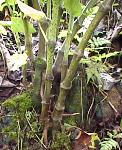
14 May 1998. The El Niño has become my summer of '98 haunt. The sakau has remained strong, viscous, and palatable. Besides usually running double sidewinder stones, the family has also exhibited a penchant for continuously loading the stone. Every twenty minutes to a half hour or so they have been tossing fresh frozen pounded sakau onto the stone. Last night I was beyond walking. Sakau is life and life is good!
30 November 1998 With the end of the El Niño, the El Niño market has essentially shut down. The market is open only irregularly and I no longer make the perfunctory swing past the market to check its status. 11 April 2001: This market is gone as far as I know, although apparently there are occasional markets up this road in 2008.

Palipowe Nett - Deke's
Throughout the summer of '97 this had been the place to be get good, strong, sohte katik sakau. This was my regular haunt on Friday evenings plus occasional Mondays and Wednesdays, the odd Thursday, and not yet on a Tuesday or Sunday. Nice view, cement pad. Clean by local standards and friendly. Comfortable benches too. With Walter or Sow on the stone and the stars over the lagoon the evening is perfect. Thanks to Walter, seen on the right, for letting him permit me to photo him as he made the power.

Seou squeezing up Palipowe way. A few years later Seou drowned off of Palipowe. Rest peace my friend.
01 Jan 98 Deke's was being operated by Salvador "Luwon - Nahnmadou" Salvador as The No Name Market while Deke built a house along the waterfront. The El Niño related drought caused the sakau plants planted on high forest hillsides to die back. One of the results is that wholesale prices are falling while the strength increases. Dry weather tends to increase sakau strength.
25 May 99 Deke's remains shut down. It was not open as of early 2001 and might not ever open again. Spring 2003: construction in the area has pretty much ruled out the market ever reappearing. That is the ephemeral nature of sakau markets.
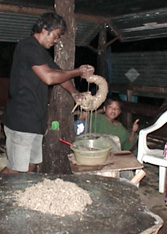
Nett Palipowe - Loyola's
No ocean view and a strong but rugged pohn takai sakau. A place that often has sakau when no else does. Politicians are often found here. The longest running bar in Palipoa if not all of Pohnpei. Remains open as of 30 November 1998. During the Fall of 1999 the market has been run, at times, by Nahnmadou, with Sau working the stone. When Nahnmadou runs the market, the sakau is often Wone, Kitti sakau, the best of the best on the island. Bearing in mind that I am biased toward Wone sakau!
Loyola's closed in 2000, as did most markets due to the cholera epidemic. The market reopened late in the year and was back to serving sakau at full Palipowe strength. Spring 2003: Not sure if the market is still being run or not. Loyola's is occasionally open in 2008.
Palipoa Nett - Aluwihse's
New minted bar (July 1997) that has started off with strong pohn takai. Capable of running three stones at a time. Being new, the politicians have been seen there in force including the Vice President of the nation and ranking Senators. Irregularly open in 1998.
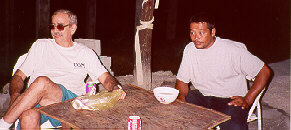
Palipoa Nett - Pohn Dow (Upon the Sacred Mouth)
Strong Palipoan sakau set in a nicely done nahs with a view of the lagoon islands. Nice sunsets when the weather cooperates. Haven't seen it open in 1999.
Palipoa Nett - Sekeren
The strongest sakau in Palipoa. A very traditional location as it is the home of the Nahnsou Sed en Nett. Frequented by men of rank. Tradition, custom, and respect are very important here. Speak when spoken to, do not interrupt anyone. Women should wear a dress with a hemline well below the knees, no pants, shorts, or mini-skirts! The sakau is served here correct by tradition as it has been for over a thousand years. 30 November 98: I have not been here in a long time. I myself am unclear as to whether the market opens or not. Nahnsou is a very high title and hence there is a shyness among drinkers to partake at his stone. Spring 2003: This market ceased to exist once Nansou rose to his current title.
Lukah
Near the Nett/U border. Serves pohn takai and bottle. On the road without a view. The noise of passing cars is offset by the see-and-be-seen nature of the market. Good woodsy upland sakau, easy to get a taxi back to town. Water source unknown. Shut down in early 1999. Money appears to have gone into starting up a taxi service. Another market has appeared (May 1999) just to the West of Lukah. The times I've swung by it was either too crowded or obviously bottle only.
Kaluhlu
Kaluhlu was located up the Nampil river road and featured sakau strong enough to cause that sought after regretful sensation. Kaluhlu sat on the bouldered banks of the Nampil, filling an evening of sakau with the sounds of water flowing over rock. A relaxing place, Kaluhlu served both communal cup from the stone and in a bottle. Although primarily a village family oriented place, the newly paved road brought in the occasional politician or business person. The single stone was continually replenished so the strength never ebbed. Being carried out was a pleasantly common occurrence. The water was village based and probably not appropriate for the casual visitor to Pohnpei. Closed in 1997.
Nakasone's
Located just before Kaluhlu, Nakasone's features remote site squeezing. A bucket brigade then moves the sakau up to a sitting hut where it is served by the cup. The sakau is a good strong Nampil variant with woodsy undertones. There is no view, just good conversation. Being a bucket and cup kind of place there is less of a traditional family atmosphere. Nakasone's is more often the haunt of the business man or person about town. The water is reportedly town water off the Nett tank. No longer open in 1998. Remained closed in 1999. The location is now secondary forest in Spring 2003.
Nan Wowin Sengen Luh
Located in the valley of Sengen Luh up the paved road that branches to the south on the western side of the Nett bridge. The sakau is served from a bottle at 35 cents a styrofoam cup. The forest location matches the woodsy undertones of the sakau. The market features three parallel tables with bamboo benches set under a single thatch hut. Do not overshoot the outhouse or one winds up in stream formed of the tears of homeward longing that remain from a time gone by. The atmosphere is local and friendly, water source unknown. Serving bottle only in 1998. Gone by 2003.
Mesenpal
25 May 1999. Mesenpal, or the Sea Shell market, is located on coralline causeway off the main circumferential road just on the Kolonia side of the Village Hotel. Mesenpal began as a pohn takai market, of late it is more regularly running as a bottle market. The sakau has been reported to me as being strong - bear in mind that I am a pohn takai devotee and leave the bottle to connoisseurs of that style of drinking. The view and environment are nothing short of the best: a wonderful ocean breeze,spectacular sunsets. This is the number one best location for a market I've seen yet. Now if they would only be a little closer to Kolonia and serve pohn takai. Mind you, the location is so spectacular that I'm looking for housing closer to there...
Kitti
Iroir market, Kitti
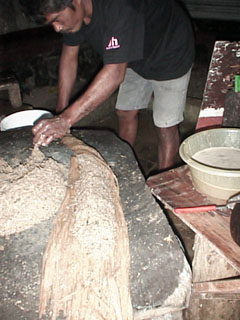
Iroir means a position oneself to have a beautiful view, to look or peer in the distance, to see one's own reflection, or to inspect one's own appearance. Iroir is set on top of an airy shoulder of a volcanic ridgeline in Kitti just past the Snowland Japanese resort and has fantastic tropical sunsets when it isn't raining. Iroir is owned and operated by the Spegal extended family and features pohn takai for tala limau, pwoatol for tala siluh, and cup laud for ehu elep. The central sakau hut is the largest hut on the island, and with the external side huts, Iroir is now the largest market on Pohnpei. Opened in November 1996, Iroir's newness and size has made it a place to be and to be seen. Expect to find Kitti's movers, shakers, and politicians there on Friday after payday at Iroir. The pohn takai is strong, served from a communal cup, the water is village based. One starts the evening enjoying the view, and ends the evening in the introspective state that good sakau inevitably brings. The only caution is negotiating the steep downhill to the road while sakaula. Closed a brief span of time later, the market has yet to reopen (May 1999).
Kaselehlie market, Pehlung, Kitti
The Kaselehlie market is an upscale bottle market located on the wooded ridgeline south of Pehlung. To reach the market, take a left on skyline road just South of Pehlung. The Kaselehlie is about a half kilometer or so up the road on the left side. Sitting on top of the ridgeline, the market features on view of the city of Pehlung spread out in the valley below.
The market seats 36 under a combination steel and thatch roof. The market is jauntily painted in white. There are four tables that seat four each under the roof, and circumferential bamboo bench seating for another 18 people. The seating can be a little hard on one's seat and back. The floor is sand and the sides are open to the air. The breeze is chilly and strong due to the location. Another dozen patrons can sit on benches scattered around outside. The bathroom is a single pit toilet, bring your own flashlight in case the house flashlight isn't around.
The sakau served on 27 February 98 was a good strong El Niño influenced Kitti stock line. The sakau is $2.00 a bottle or 40¢ a styrofoam cup. The local rate in Pehlung currently is $1.75 a bottle and 25¢ a cup - making the market the local equivalent of a high class tavern. Ngarangars are available on request.
The bottles are served by Pehlung's loveliest young women. The market is also frequented by some Pehlung's best looking eligible bachelors. Sakau always tastes better if the market affords a view of beauty. The only downside is the distance home for K-town residents when one is sakaula. Status unknown in 1999.
Wone
Wone, Kitti, features village based family style sakau typically in a traditional setting. Out here the sakau places are temporal, opening and closing with the passing yam and breadfruit seasons. The sakau is always strong, the drinkers are purely local. Wone is nestled amidst the rain forest at the base of the mountains of southern Kitti. Politicians rarely find their way out here except in an election year in part due to the current condition of the road. The water is village surface based, and sakau in the village usually means overnighting in the village. The completion of the circumferential road paving now makes it theoretically possible to enjoy sakau in Wone and return to a home on the north side, but those who would choose to do this are a rare breed.
Nan Mut (Upon the cut place)
The oldest and longest running of markets, home of Half Case the market dog. Thirty cents a cup served in the round under a thatch roof.
Pohn Pwel (In the dirt)
A wreck of a building that serves forty cent a cup sakau to the true local lover. A favorite of mine due to the short stagger home for a Luak resident.
Likapw Salohi (Drunkeness) Also called "Jealousy"
A market that makes an effort to be tourist oriented. Lacks only tourists to enjoy the view. Set along a river, Mikary's place is the largest thatch roof in Wone. Likapw is only a few months old and attracts a younger crowd than the older markets. I believe this market has shut down (May 1999). Wone, however, always has something open. Ask around.
U
Nahmw Pou, U
Set on a windward and ancient stone platform upon the reef flat in U, Nahmw Pou (The Cold Abyss) allows a descent into the depths of cool sleep with an expansive view of U, Madolenihmw, and the ever present deep lagoon. Owned and operated by Ioanis Donre, Nahmw Pou has the look and fell of down home sakau. Where other markets are separate places of business, Nahmw Pou is the Donre family home. Customers are both guests and family at the same time. This is not a place to which a sakau stone was recently dragged, like Pohn Dow this is an ancient hearth. Upon this place a stone has sung for many centuries. I have not gone out this way in 1999.
Nan Peri, U
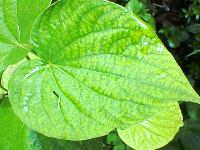
30 November 98. Patricio's place is up the Awak River in U. Make a right at the paved road just before the church in Awak if coming from Kolonia. Set amid stands of bamboo, Nan Peri serves strong brews from U. Although bit far from town, Nan Peri is located quite close to The Village hotel. Sakau is usually served Wednesday, Thursday, and Friday nights. Call 320-4740 to see if the market is open. The market sports its own taxi service, call 320-3588 to reach the taxi service.
Unknown, Western U
I have not been there, but I am told that the first market on the right after crossing the U border with Nett heading toward Awak serves a strong and tasty brew of sakau. The water line has been extended to Awak, so this may now be town water out here.
Benders
So you want to go on an every night bender, drinking nightly for four hours every night until you are pwopwuda and masapang. My first advice is don't. Your doctor will also tell you don't. But if you insist... First, you must be a resident of Pohnpei with tolerance for our water and any stray bacteria you might consume. Second, stick to high mataitai sakau, the super slime heavy duty stone brew. Avoid watery, thin, and weak sakau. If you cannot tell the difference between a strong brew and a weak brew you have no business trying to pull an every nighter.
Once on the bender do not quit for even one night until you are ready to bust the bender. Sakau is not addictive per se, but for most people there is rebound insomnia after a bender. The exception is people who are not made sleepy by sakau, but they may be guilty of drinking weak stuff.
During the bender hydration and nutrition will be critical. Drink at least one coconut every day with a pinch of salt. Drink water continuously, interspersed with a sports drink. Take vitamins, loading up on extra vitamin A if you can. Eat before and after your evening sakau. Use coconut oil after every shower. If you have to work in an air conditioned office, then keep a bottle of skin lotion handy and apply liberally every two hours. To the extent possible, eat greasy foods - your skin will need the oil. Do not worry, you will not gain weight while on a bender, but that does not make the combination heart healthy by any means. Some every nighters swear by milk. I knew a fellow who drank a liter of milk every day.
I would avoid alcohol as it adds to your general dehydration and gives the liver extra work. Besides, every night drinkers who follow their sakau with a couple or more beers are the only ones who do appear to gain weight over time. Be careful washing clothes: do not get bleach on your skin. It will burn like a fire. No permanent damage, just painful. Shower with the gentlest skin care soap you can find.
After 22 day bender in 2001 it took me four nights to get a somewhat normal night of sleep. My skin recovered in about the same time frame. I suspect there is an elevated risk of kidney stones if one remains on sakau every night for years, but it is hard to sort out from the elevated risk of kidney stones that all of us face in the humid tropics. Of interest to me was the sense that my papery dry, thin skin was that of an old man. I noted that the dryness of the skin decreased sensation in my fingertips. I felt as though I were getting a taste of being eighty-five. At the end of the binge when I went to pick up my kid, who had been off-island during the binge, I could not feel the softness of their skin.
Overall, a bender is something that will give your doctor a heart attack. Something to be done maybe once in a life, but not something one can maintain indefinitely. Those who drink every night tend to consume on the order of two to three cups a night. Fall 2006 a study was done of cups per customer in four markets. The study found a mode of one cup with means ranging from three cups out in Pehleng to five at Rush Hour in Nett near Kolonia. That study exists also as an OpenOffice document and PDF file.
Sakau market stylistics
In the nahs sakau is served according to tradition in accordance with tiahk en sahp. Only one person speaks at a time. In a formal setting this would be the menindei. Even at informal family sakau those speaking are usually higher titled family elders. The emergence of the sakau market has engendered new behaviors, new styles of consuming sakau. These behaviors were always there - even at home the talker was known for their propensity to hold the cup in their right hand, left hand on their left knee with the elbow akimbo, talking until their better half called their title in a quiet whisper. A reminder to take their sip and pass the cup. Slammers were in the nahs as well, downing the ngarangar and then passing a few rounds. To avoid resentment, however, slammers also usually had to take a pass on the first few rounds, throttling back their natural propensity to slam.
Slammers
Slammers are market drinkers who slam down whole coconut cups or cups of sakau in one go. Downing an eight ounce glass of slime is for the veteran drinker only, and even many vets never learn to slam. There are a few men, well known by name, who always drink fast and furious. They want the feeling and only the feeling, they are not in market for small talk and chit-chat. This style of drinking is somewhat rare and is, as far as I know, confined to men. At least one slammer in this author's acquaintance gets irritated by talkers, fortunately he is happily in that other place before he can get agitated enough to punch out a talker. Do not disturb sleeping gentle giants, they are still giants.
Talkers
Talkers go to market to talk and socialize. They will sip at the coconut cup, or nurse a cup or two through a whole evening. While this is likely the normal mode of drinking for women in the markets, men who take to this style are often noted for their propensity to talk at sakau. Talkers are more common than slammers. Slammers may look down on talkers as wasting time, while talkers may think of slammers as there only for the feeling - missing out on the importance of market sakau as a place of communication.
Drivers
Some drinkers like to drive after sakau. The slow drive intensifies the feeling for these drinkers. In extreme cases some drivers go the longest way home, or volunteer to drop off car-less friends after sakau. Drivers are also often known by name, and may even be remembered for their penchant for driving long after they have passed on. In one case a respected elder driver who lived in Kolonia drank in Wone, Kitti, almost twenty-six winding mountain road miles from his home in order to have a nice long drive home.
Oualik en Pahnais
Pohnpei 09 December 2008
Sakau en Pohnpei Nights